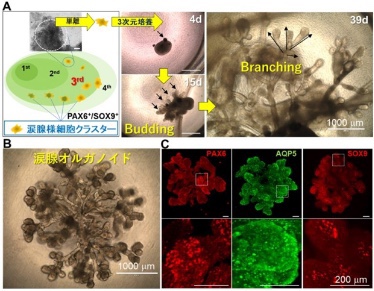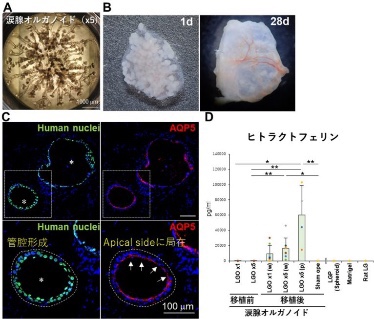

Osaka University: Creating artificial lacrimal glands with iPS:
-Expected to treat severe dry eye for the first time in the world-
Osaka University
Professor Ryuhei Hayashi
For the first time in the world, we succeeded in “creating a three-dimensional tissue similar to the lacrimal gland of the eye from iPS cells.”
It was announced on April 20th in the English scientific journal Nature.
Immune disease
Sjogren’s Syndrome
The surface of the eye is prevented from drying out by the tear fluid secreted by the lacrimal glands.
In the immune disease “Sjogren’s syndrome”
The function of the lacrimal glands is impaired, resulting in heavy dry eye.
The lacrimal glands do not regenerate in adults and there is no radical cure.
Lacrimal gland tissue production with iPS cells:
Create cells that are the basis of lacrimal glands from human iPS cells.
A mini-sized three-dimensional lacrimal gland tissue with a size of several millimeters was created.
It will lead to the development of treatments and medicines for severe dry eye.
Kyodo News
https://nordot.app/889526814941822976
Established a method for producing lacrimal gland organoids from iPS cells
-New technology to accelerate regenerative medicine and drug discovery research for severe dry eye-
Osaka University Graduate School of Medicine / Faculty of Medicine
https://www.med.osaka-u.ac.jp/activities/results/2022year/hayashi2022-4-19
Université d’Osaka : Création de glandes lacrymales artificielles avec iPS :
-Devrait traiter la sécheresse oculaire sévère pour la première fois au monde-
Université d’Osaka
Professeur Ryuhei HayashiPour la première fois au monde, nous avons réussi à “créer un tissu tridimensionnel semblable à la glande lacrymale de l’œil à partir de cellules iPS”.
Il a été annoncé le 20 avril dans la revue scientifique anglaise Nature.
Maladie immunitaire
Le syndrome de SjogrenLa surface de l’œil est empêchée de se dessécher par le liquide lacrymal sécrété par les glandes lacrymales.
Dans la maladie immunitaire “syndrome de Sjogren”
La fonction des glandes lacrymales est altérée, ce qui entraîne une sécheresse oculaire importante.
Les glandes lacrymales ne se régénèrent pas chez l’adulte et il n’y a pas de remède radical.
Production de tissus des glandes lacrymales avec des cellules iPS :
Créer des cellules qui sont à la base des glandes lacrymales à partir de cellules iPS humaines.
Un tissu de glande lacrymale tridimensionnel de taille mini d’une taille de plusieurs millimètres a été créé.
Cela conduira au développement de traitements et de médicaments pour la sécheresse oculaire sévère.
Nouvelles Kyodo
Mise en place d’une méthode de production d’organoïdes de la glande lacrymale à partir de cellules iPS
-Nouvelle technologie pour accélérer la médecine régénérative et la recherche sur la découverte de médicaments pour la sécheresse oculaire sévère-
École supérieure de médecine de l’Université d’Osaka / Faculté de médecine
Universität Osaka: Herstellung künstlicher Tränendrüsen mit iPS:
-Erwartet, dass zum ersten Mal weltweit schweres Trockenes Auge behandelt wird-
Osaka-Universität
Professor Ryuhei HayashiWeltweit erstmals ist es uns gelungen, „aus iPS-Zellen ein dreidimensionales Gewebe ähnlich der Tränendrüse des Auges herzustellen“.
Es wurde am 20. April im englischen Wissenschaftsjournal Nature angekündigt.
Immunkrankheit
Sjögren-SyndromDie Augenoberfläche wird durch die von den Tränendrüsen abgesonderte Tränenflüssigkeit vor dem Austrocknen bewahrt.
Bei der Immunkrankheit “Sjögren-Syndrom”
Die Funktion der Tränendrüsen ist beeinträchtigt, was zu einem starken Trockenen Auge führt.
Die Tränendrüsen regenerieren sich bei Erwachsenen nicht und es gibt keine radikale Heilung.
Produktion von Tränendrüsengewebe mit iPS-Zellen:
Erstellen Sie aus menschlichen iPS-Zellen Zellen, die die Basis von Tränendrüsen bilden.
Es entstand ein dreidimensionales Tränendrüsengewebe im Miniformat mit einer Größe von mehreren Millimetern.
Es wird zur Entwicklung von Behandlungen und Medikamenten für schweres Trockenes Auge führen.
Kyodo-Nachrichten
Etablierung einer Methode zur Herstellung von Organoiden der Tränendrüse aus iPS-Zellen
-Neue Technologie zur Beschleunigung der regenerativen Medizin und der Arzneimittelforschung für schweres Trockenes Auge-
Graduiertenschule für Medizin der Universität Osaka / Medizinische Fakultät
Generation of 3D lacrimal gland organoids from human pluripotent stem cells
Abstract
Lacrimal glands are the main exocrine glands of the eyes.
Situated within the orbit,
behind the upper eyelid and towards the temporal side of each eye, they secrete lacrimal fluid as a major component of the tear film.Here we identify cells with characteristics of lacrimal gland primordia
that emerge in two-dimensional eye-like organoids cultured from human pluripotent stem cells1.
When isolated by cell sorting and grown under defined conditions,
the cells form a three-dimensional lacrimal-gland-like tissue organoid with ducts and acini, enabled by budding and branching.
Clonal colony analyses indicate
that the organoids originate from multipotent ocular surface epithelial stem cells.
The organoids exhibit notable similarities to native lacrimal glands on the basis of their morphology,
immunolabelling characteristics
and gene expression patterns,
and undergo functional maturation when transplanted adjacent to the eyes of recipient rats, developing lumina and producing tear-film proteins.Nature